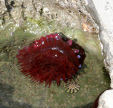 |
| to |
 |
|

Glamorgan 35 |

Glamorgan 41 |

Glamorgan 47 |

Glamorgan 60 |
The Glamorgan Heritage Coast stretches for 14 miles, with distinctive cliffs, rocky wave-cut platforms and rock pools, sandy beaches, and fresh-water springs with colourful moss and algae growths. The 18 mile coast path can be walked in one go or in short sections. |

